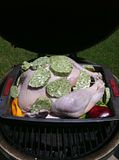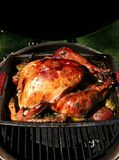Share your photos by tagging us and using the hashtag #BigGreenEgg.
Want to see how the EGG is made? Click to Watch
Continued Discussion of Turkey Cooking Temps

I ran across this 15 year old article from the NY times when doing some research on Turkey cooking temperatures. With a few modifications you could easily see the recipe transferred to the more appropriate cooking ability of the egg vs the oven. I am curious though at each of the temperatures discussed over the last couple of weeks on the forum (250-500 degrees) is there meat texture variation to be considered, limitations on external seasoning due to burning, etc?
I cooked a 7.5lb turkey breast only yesterday at 350-375 dome and although I didn't particularly care for the flavor of the brine I made (my own worst critic), nor the results of the skin with the rub i used, once I pulled the skin off, the juciness of the meat was second to none.
High-Heat Roasting Makes Tom Turkey A Bird of Paradise
Published: November 27, 1996
A STARTLING and relatively new method for roasting poultry can make even today's bland, overbred turkeys memorable. The blast-heat method will produce a crisp-skin bird with moist, intensely flavorful white and dark meat.
For 25 years, I have been an unbearably smug turkey cook, turning out bronzed picture-perfect birds. My tried and true cooking method was ridiculously simple: 450 degrees for the first 20 minutes, then 325 for the remainder of the cooking time. For moisture, I draped the bird with cheesecloth soaked in oil and butter, and basted periodically.
But turkeys have changed. Increased standarization and over-breeding of big birds have created turkeys that keep gaining in size but losing in flavor.
In an attempt to recapture that original turkey taste, I roasted 19 turkeys in the last month, using a variety of methods. Each turkey was 12 to 14 pounds, bought fresh at butcher shops or supermarkets.
For my home-kitchen electric-oven marathon, I tried cooking in a paper bag (unsafe if there are chemicals in the paper), wrapping in foil, draping in caul fat, turning the breast downward for part of the cooking, basting constantly, cooking at different temperatures and oiling the bird under the skin.
Turkey No. 19, cooked quickly at a constant 500 degrees, was the triumph. The reasons: no stuffing (which blocks an even flow of heat); no basting (which softens the skin and keeps it from becoming crisp); no turning from side to side or upside down (which lets the juices run out), and no overcooking.
High heat intensifies flavor. For turkey, it crisps the skin and drives excess fat and water out of the bird, which bastes as it goes.
Last year, when I used the high-heat method pioneered by Barbara Kafka, I ended up with a smoky kitchen. I now know that the culprit was my 20-year-old, blue-speckled enamel roasting pan, which was not strong enough to take the heat.
This year, I tried again with a heavy metal roasting pan. The resulting turkey was worth celebrating. Here's what you need:
Use a heavy 18-by-20-inch aluminum or stainless-steel roasting pan about 2 inches deep (no deeper or the turkey will steam). Disposable aluminum pans are unsafe for this job.
Use heavy pot holders.
Have ready a V-shape, adjustable rack that fits the pan. The rack will cradle the bird and lift it off the bottom so the underside will brown.
Use an instant-read thermometer; the pop-up kind is unreliable.
Make sure your oven is clean; accumulated debris can cause smoke during high-heat cooking. Here are the steps for roasting:
1. Remove the fresh, not frozen, turkey from the refrigerator two hours before it is to be cooked. Putting a cold bird into a hot oven can only send it into shock.
2. Remove and reserve the giblets and neck from the turkey cavities.
3. Rinse the turkey, inside and out, under cool running water. Without blotting dry, put it breast side up on the V-shape rack, set at the lowest slot, in the roasting pan. Drape a clean tea towel over the bird to keep it from drying while it warms.
4. Put the giblets and neck in a saucepan, add six cups of water or chicken stock, and let simmer an hour or until reduced to four cups.
5. Put oven rack at its lowest level.
6. Heat the oven to 500 degrees half an hour before cooking time. At this temperature, figure on eight minutes of cooking to a pound; an average 14-pounder will be done in about an hour and a half.
7. Remove the towel from the turkey. Do not season, stuff, truss or skewer the bird. But spread the drumsticks as far apart as possible without breaking the skin.
8. Put the turkey in the oven with the drumsticks toward the door. Let it cook undisturbed for 45 minutes. Do not even open the oven door during this time.
9. After 45 minutes, if smoke is coming from the oven and the fat is spitting, pour a cup of tepid water in the roasting pan. If necessary, turn on the exhaust or open a window to clear the kitchen of smoke. Resist the temptation to baste.
10. When the turkey is evenly brown, cover the breast loosely with a sheet of heavy-duty aluminum foil to keep it from browning too much.
11. After 60 minutes, remove the roasting pan from the oven and check the turkey's temperature with the instant-read thermometer. Stick it into the thickest part of the thigh, next to the carcass, without touching the bone. The turkey is done when the thigh registers 165 to 170 degrees. The turkey will continue to cook while it rests for 20 minutes outside the oven before it is carved; during this time, the temperature will increase 5 to 10 degrees.
12. When the turkey is done, let it rest on its rack for 10 minutes. Transfer it to a serving platter. Discard all but four tablespoons of fat from the roasting pan. Pour in the four cups of stock and reduce over high heat to two cups, about 10 minutes. Season with salt and pepper. Serve and exult.
http://www.nytimes.com/1996/11/27/garden/high-heat-roasting-makes-tom-turkey-a-bird-of-paradise.html
Comments
-
the first time i tried doing a turkey on the egg i asked and found the mad max turkey. although i do not follow his directions to the t i do use alot of the info when i cook my bird. i figured if anyone can tell me how to cook a bird on the egg it should be a fellow egger here is a link for you
http://www.nakedwhiz.com/madmaxturkey.htm


happy eggin
TB
Anderson S.C.
"Life is too short to be diplomatic. A man's friends shouldn't mind what he does or says- and those who are not his friends, well, the hell with them. They don't count."
Tyrus Raymond Cobb
Categories
- All Categories
- 182.7K EggHead Forum
- 15.7K Forum List
- 459 EGGtoberfest
- 1.9K Forum Feedback
- 10.3K Off Topic
- 2.2K EGG Table Forum
- 1 Rules & Disclaimer
- 9K Cookbook
- 12 Valentines Day
- 91 Holiday Recipes
- 223 Appetizers
- 516 Baking
- 2.4K Beef
- 88 Desserts
- 163 Lamb
- 2.4K Pork
- 1.5K Poultry
- 30 Salads and Dressings
- 320 Sauces, Rubs, Marinades
- 543 Seafood
- 175 Sides
- 121 Soups, Stews, Chilis
- 35 Vegetarian
- 100 Vegetables
- 313 Health
- 293 Weight Loss Forum
